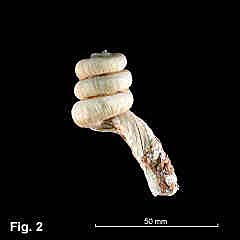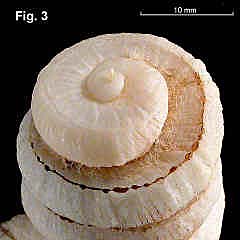|
|
|
|
|
Tenagodus ponderosus Mörch, 1861 Description: Early whorls regularly coiled, low or flat; then 2 or 3 large, regularly coiled whorls; then a straight or bent uncoiled tube. Regularly coiled section sculptured with deep, irregular transverse fissures; longitudinal threads sometimes present on uncoiled section. Slit closed on early whorls, progressively becoming a series of elliptical holes; then open with serrated sides; then for most of the uncoiled part of the shell, a very narrow smooth-sided slit; then closed for last few centimetres in mature shells. Aperture circular, lip thin and irregular. Interior smooth, white and polished. Colour white, fawn, brown, grey or purple. Size: Large specimens in the Australian Museum collection 180 mm in length, with tube external diameter 17 mm. Type description gives length as 440 mm. Distribution: Indo-West Pacific; in eastern Australia, as far south as Sydney. Habitat: Lives embedded in sponge, intertidal and subtidal. Empty and broken shells are common on northern Australian beaches. Comparison: This species is distinguished by its large size and characteristic form of low or flat early whorls, followed by two or usually three regularly coiled whorls. Synonymy: No common synonyms in Australian literature. Remarks: This species has not previously been recorded from NSW. There are specimens from Coffs Harbour and Sydney in the Australian Museum Collection. Fig. 1: Weld Island, north west Australia; intertidal in sponge (DLB4766) Fig. 2: Weld Island, north west Australia; intertidal in sponge (DLB4766) Fig. 3: Same specimen as Fig. 2 |


